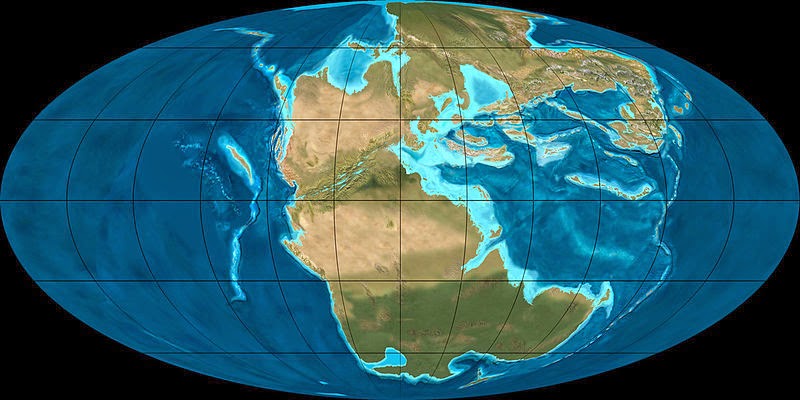Overview - Timescale, Physical Landscapes
GEOL.3310 :: Phanerozoic Eon (538.8 ± 0.2 – 0 Ma) :: Mesozoic Era (251.902 ± 0.024 – 66.0 Ma) :: Mesozoic Era (251.902 ± 0.024 – 66.0 Ma) :: Triassic Period (251.902 ± 0.024 – 201.4 ± 0.2 Ma)
Page 1 of 1
 Overview - Timescale, Physical Landscapes
Overview - Timescale, Physical Landscapes

The Triassic marked the beginning of major changes in the distribution of continents, the evolution of life and the geographical distribution of organisms during the Mesozoic Era. At the beginning of the Triassic, almost all of the world's major land masses were centered on a supercontinent called Pangea. The climate on Earth was hot and dry and the crust was relatively calm. However, from the end of the Triassic, plate tectonics became active and continental drift began. By the end of the Permian, shallow seas, diminishing in area, spread along continental margins, and as sea levels gradually rose, continental shelf seas were inhabited for the first time by large marine reptiles and the organisms that form modern coral reefs.
- 358.9 - 298.9 ma
- Division of Paleozoic era
Phanerozoic eon
Mesozoic Era - Triassic Period
- Lower
- Induan
- Olenekian
- Middle
- Anisian
- Ladinian
- Upper
- Carnian
- Norian
- Rhaetian
At the beginning of the Triassic period, the continents of the present-day world were grouped into a large C-shaped supercontinent called Pangea. It consisted of the northern continent Laurasia and the southern continent Gondwana. The northern continent was called Laurasia and the southern continent Gondwana, while the rest of the world was covered by a large ocean called Panthalassa.
On the western edge of what is now North America, there was a large subduction zone where the eastward-moving Panthalassa oceanic plate slid under the continental plate of Pangaea. The Panthalassa plate carried island arcs and micro-continent debris but could not subduct with the oceanic plate due to its low density.
Mountain building during the Triassic was limited by relatively small-scale orogenic activity along the Pacific margin of North America, China and Japan. The absence of metamorphism in the Triassic rocks of the Newark Formation in eastern North America, known for dinosaur tracks and freshwater fossils, suggests that its sediments were deposited after the main Appalachian orogenic phase of the late Paleozoic.
 Similar topics
Similar topics» Overview - Timescale, Physical Landscapes
» Overview - Timescale, Physical Landscapes
» Overview - Timescale, Physical Landscapes
» Overview - Timescale, Physical Landscapes
» Overview - Timescale, Physical Landscapes
» Overview - Timescale, Physical Landscapes
» Overview - Timescale, Physical Landscapes
» Overview - Timescale, Physical Landscapes
» Overview - Timescale, Physical Landscapes
GEOL.3310 :: Phanerozoic Eon (538.8 ± 0.2 – 0 Ma) :: Mesozoic Era (251.902 ± 0.024 – 66.0 Ma) :: Mesozoic Era (251.902 ± 0.024 – 66.0 Ma) :: Triassic Period (251.902 ± 0.024 – 201.4 ± 0.2 Ma)
Page 1 of 1
Permissions in this forum:
You cannot reply to topics in this forum|
|
|
